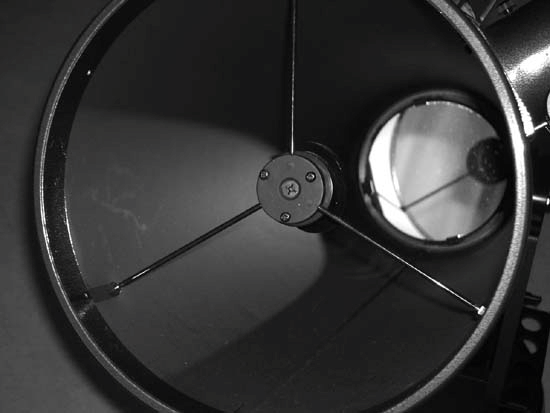Hack36.Eliminate Diffraction Spikes and Increase Contrast
Hack 36. Eliminate Diffraction Spikes and Increase Contrast
Build a $0 aperture mask to turn your $500 Dob into a $2,000 apo refractor. Well, not really. But a simple, cheap hack can let your inexpensive Dob provide most of the benefits of an expensive apo refractor. Read on. There's an old saying among astronomers: Aperture Rules. And it's true. A larger aperture gathers more light and provides higher resolution of fine detail. Assuming the larger scope has at least decent optics, you can simply see more with a larger scope than with a smaller one, period. That's the reason Newtonian reflectors, particularly Dobsonians, are so popular. They provide a lot of decent-quality aperture for not much money. But if you attend a large star party, you'll see something puzzling. There'll be a lot of people using Dobs up to 20" or larger. There'll also be a lot of people using 8", 10", and 12" SCTs. But mixed in with these mid-size and large scopes, you'll see a fair number of people using 3" to 5" premium apochromatic refractors, such as those made by Tele Vue, Takahashi, and TMB. And those refractors, small as they are, aren't cheap. Even a small apochromatic refractor can easily cost $2,000 or more without a mount. The 5" models sell for $4,500 and up. So why would anyone pay so much for such a small scope? In a word, image quality. (Well, OK, two words.) The big Newtonian reflectors and SCTs provide a lot of aperture, but they are obstructed scopes. They have a secondary mirror in the light path and, in the case of Newts, a spider assembly and secondary holder as well. Figure 3-9 shows a view looking down the tube of our Newtonian reflector. The 10" primary mirror is visible at the back of the tube. The secondary holder, held by its three spider vanes, is visible at the front of the tube. Figure 3-9. The secondary holder and spider vanes of a Newtonian reflector All of that gubbage in the light path has two undesirable effects:
Refractors have no central obstruction, and so do not suffer from these diffraction effects. The upshot is that refractors provide sharp, high-contrast views that are more esthetically pleasing to many observers than the views through a Newt or SCT. But the superiority of a refractor view is an illusion. A larger obstructed scope provides more image detail than a small refractor, but the image is not as pleasing. Still, a lot of astronomers are willing to pay large sums for that pleasing image.
If you have a medium or large Dob or other obstructed scope, you can gain most of the benefits of that $2,000 apo refractor at a cost of $0 and a few minutes' work. All you need is a sheet of cardboard, a ruler, a compass, a pencil, and a sharp knife. You'll use these to build an off-axis sub-aperture mask, usually called an aperture mask for short. An aperture mask blocks the scope's aperture entirely except for a small off-center circular hole, cut so the secondary holder and the spider vanes do not intrude. Light enters the scope only through that off-axis hole. Because the secondary holder and spider vanes are masked off, they contribute no diffraction to the image. In effect, the large masked mirror functions like a small mirror without any obstruction. To create an aperture mask for your scope, follow these steps:
To install the aperture mask, simply slide it into the front of the tube, arranging it so that none of the spider vanes are visible through the aperture. As it happened, we installed our aperture mask, shown in Figure 3-10, with the aperture hole near the focuser. We could have placed the mask between any two of the vanes. Unless your mirror is hideously bad, it doesn't matter which pair of vanes you choose. Figure 3-10. The aperture mask in place on our 10" Dob So how does it work? Pretty well, actually, if you like the idea of turning a 250mm scope into an 85mm scope. The 85mm aperture-masked scope is a lot dimmer than a 250mm scope, and it can't resolve detail as finely. But it does provide the kind of image you'd expect looking through a $2,000 85mm apochromatic refractor. Sharp, snappy, high contrast, and visually pleasing, with no false color or other aberrations. An inexpensive Dob with an aperture mask isn't the true equivalent of the expensive apo, of course. If it were, no one would buy apo refractors. If you think of the apo as a fine Swiss watch, the Dob is more like a crude Soviet tank. If you value fine workmanship, the apo refractor is simply in a different class. The other difference is focal length. A typical 85mm or 90mm apo refractor has a focal length of 450mm to 600mm. Our 85mm aperture-masked Dob still has the native focal length of the underlying scope, 1,255mm. At high magnification, such as for Lunar and planetary viewing, the different focal lengths don't matter. But for rich field viewing, such as browsing Milky Way star fields, the shorter focal lengths of the apo refractors give them a huge advantage. Our aperture-masked Dob has a maximum possible true field of about 2°, versus twice that or more for the apo refractors. Is it worth building an aperture mask yourself? Sure, why not? It costs next to nothing, takes only a few minutes to do, and you may fall in love with the apo-like images. But before you decide to make the aperture mask a permanent part of your observing kit, we suggest you do some side-by-side comparisons. View the Moon, planets, double stars, and other objects with and without the mask in place. We think you'll decide, as we have, that the advantages of larger aperture greatly outweigh the disadvantages. |
EAN: 2147483647
Pages: 112
